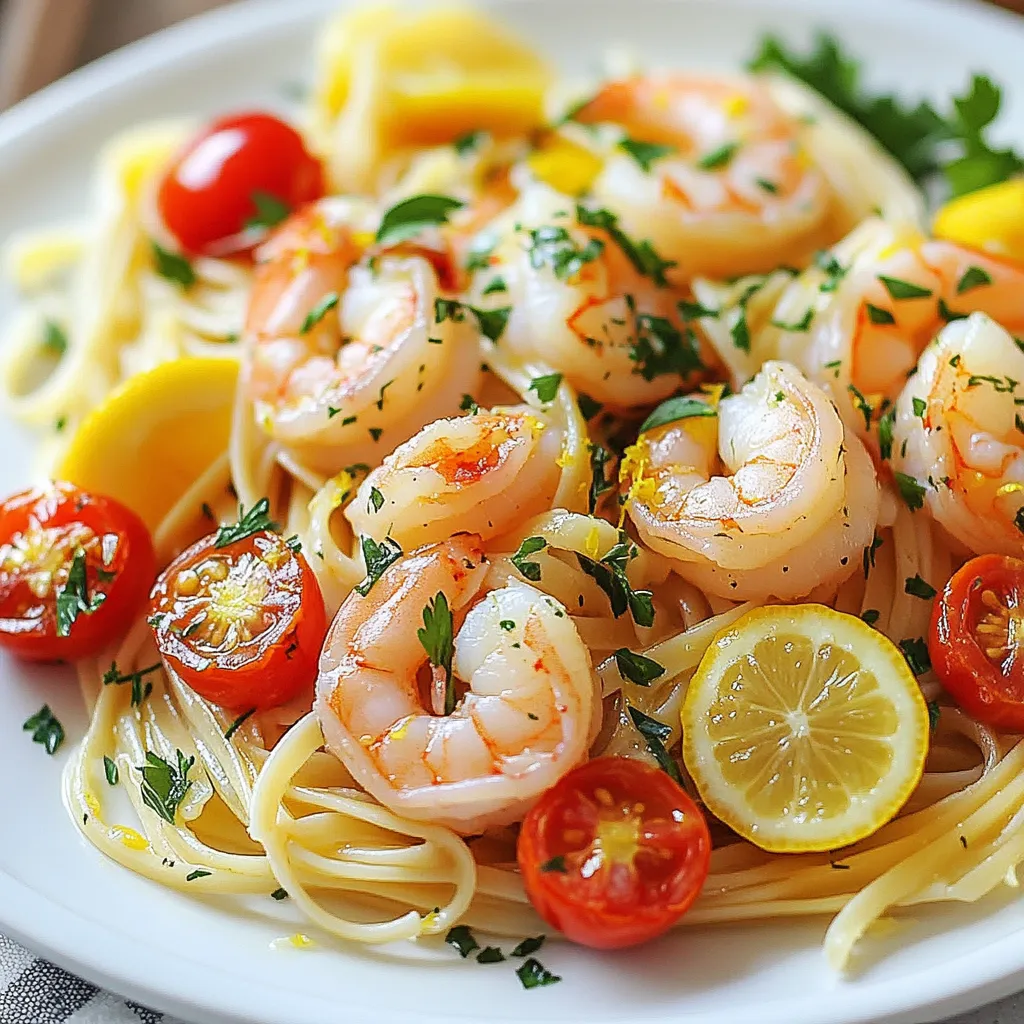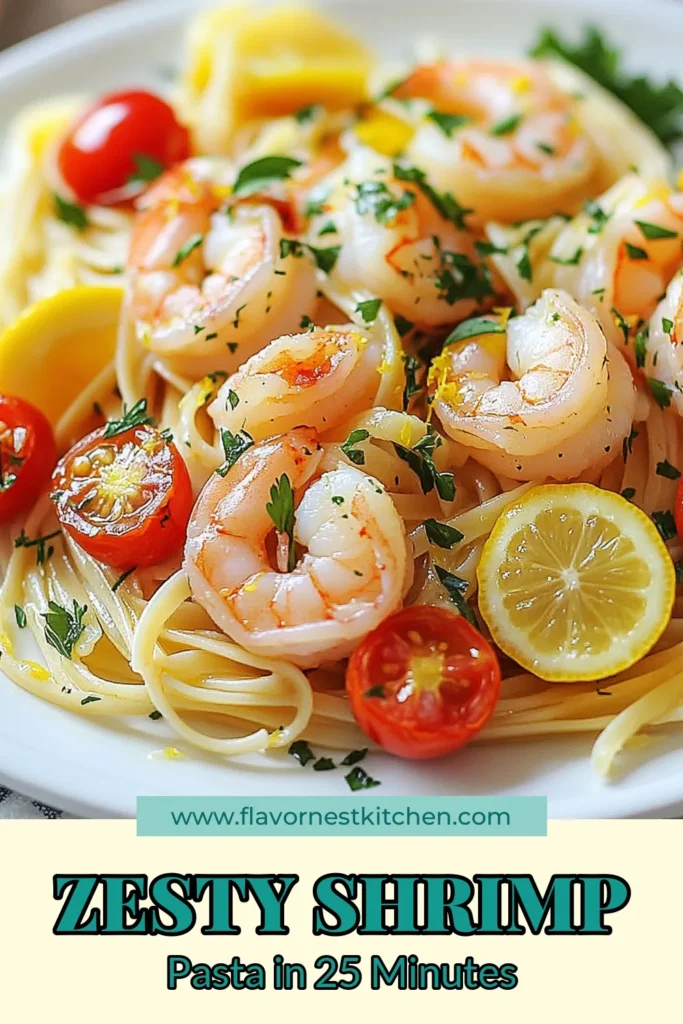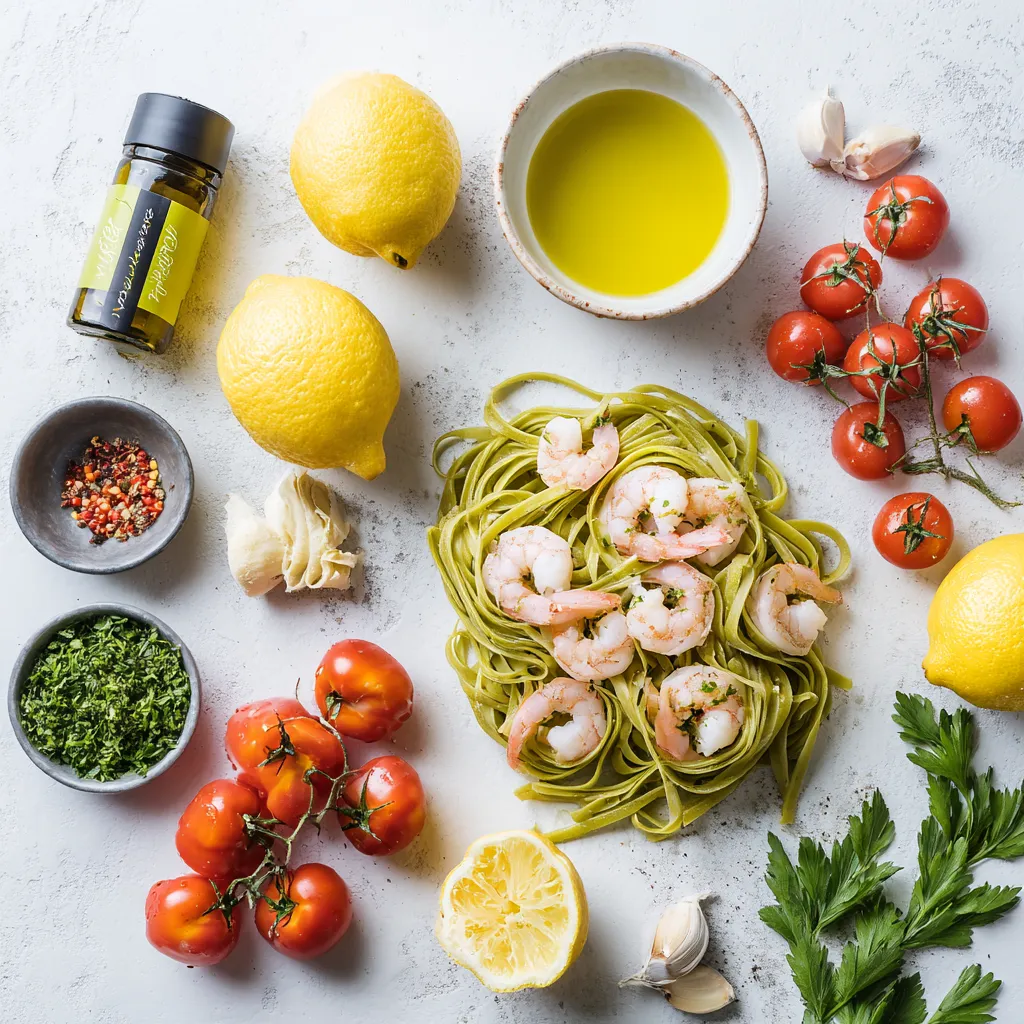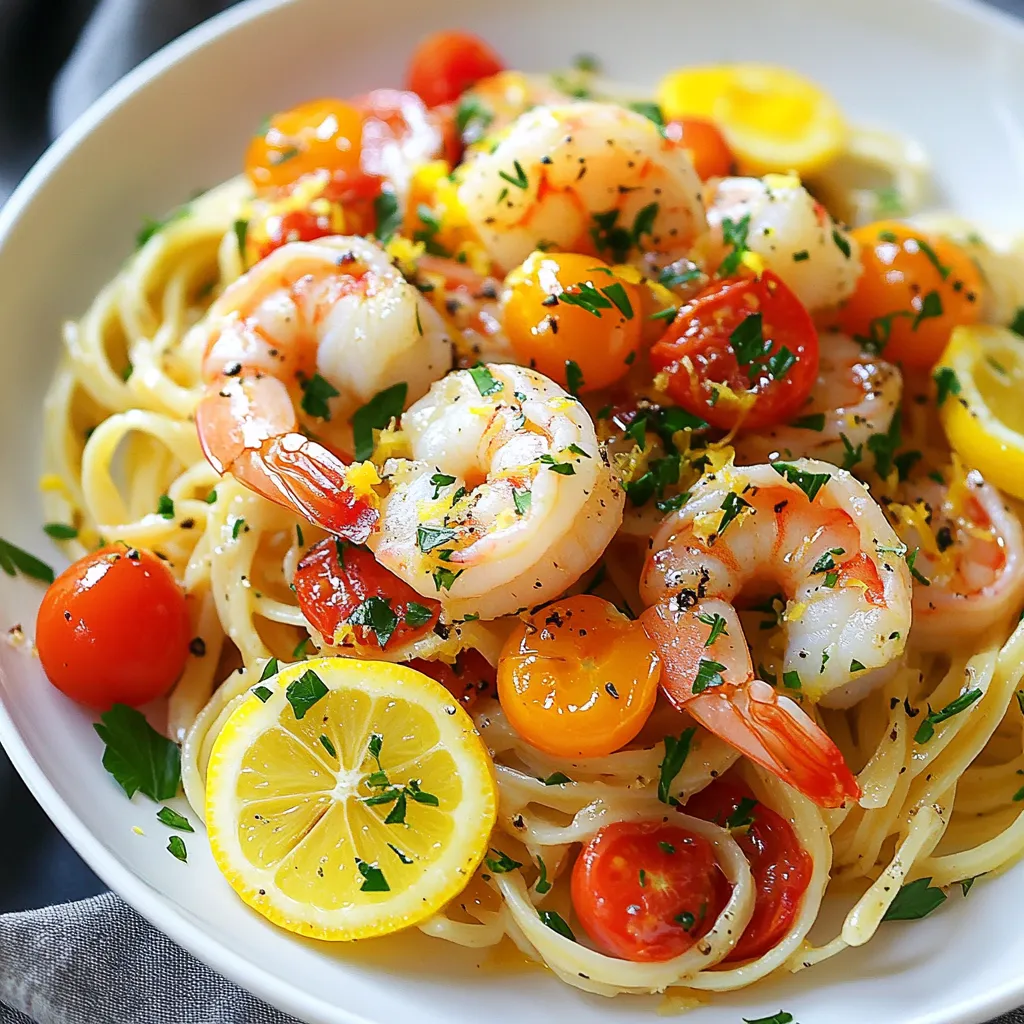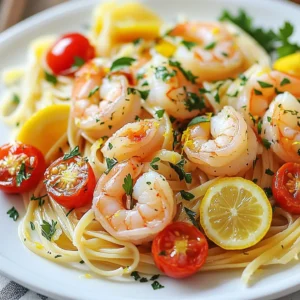WANT TO SAVE THIS RECIPE?
Looking for a quick and tasty meal? You’ll love this Lemon Garlic Shrimp Pasta! It’s packed with flavor and takes only minutes to prepare. Perfect for busy weeknights, this dish impresses without the fuss. I’ll guide you through easy steps and helpful tips to make this meal a new favorite. Let’s dive into the delicious world of shrimp pasta that’s sure to please everyone at your table!

Why I Love This Recipe
- Quick and Easy: This recipe can be prepared in just 25 minutes, making it perfect for a weeknight dinner or a last-minute gathering.
- Bright and Flavorful: The combination of lemon and garlic gives this dish a zesty flavor that is both refreshing and satisfying.
- Healthy Ingredients: With shrimp, cherry tomatoes, and fresh parsley, this pasta dish is packed with nutrients and good-for-you ingredients.
- Customizable: You can easily adjust the spice level or add other vegetables to make the dish your own!
Ingredients
List of Ingredients for Lemon Garlic Shrimp Pasta
To make Lemon Garlic Shrimp Pasta, you need these simple ingredients:
– 8 oz linguine or spaghetti
– 1 lb large shrimp, peeled and deveined
– 3 tablespoons olive oil
– 4 cloves garlic, minced
– 1 teaspoon red pepper flakes (adjust to taste)
– Zest of 1 lemon
– 1/4 cup fresh lemon juice (about 2 lemons)
– 1/2 cup cherry tomatoes, halved
– 1/4 cup fresh parsley, chopped
– Salt and pepper to taste
– Grated Parmesan cheese (optional)
Ingredient Alternatives and Substitutions
If you don’t have all the ingredients, here are some easy swaps:
– Use any pasta you like, such as fettuccine or penne.
– Swap shrimp for scallops or chicken.
– Use garlic powder if you run out of fresh garlic.
– For a spicy kick, try using fresh chili peppers instead of red pepper flakes.
– If you want a twist, add spinach or arugula for extra greens.
These swaps keep the dish tasty while fitting your pantry.
Nutritional Information for Key Ingredients
Here’s a quick look at the nutrition for some of the main ingredients:
– Shrimp: High in protein and low in calories. Good source of omega-3 fats.
– Olive Oil: Contains healthy fats. It’s good for heart health.
– Garlic: Has many health benefits, including boosting your immune system.
– Lemon Juice: Rich in vitamin C. Helps with digestion and adds flavor.
– Pasta: Provides carbohydrates for energy. Choose whole grain for added fiber.
This dish balances flavor and nutrition, making it a smart meal choice.

Step-by-Step Instructions
Detailed Cooking Instructions
1. Start by bringing a large pot of salted water to a boil.
2. Add 8 ounces of linguine or spaghetti. Cook it according to the package instructions until it is al dente.
3. Reserve one cup of pasta water before draining the pasta. Set the pasta aside.
4. While the pasta cooks, heat 2 tablespoons of olive oil in a large skillet over medium heat.
5. Add 4 cloves of minced garlic and 1 teaspoon of red pepper flakes. Sauté for about one minute, but don’t let the garlic burn!
6. Turn up the heat to medium-high. Add 1 pound of large shrimp, peeled and deveined. Season with salt and pepper.
7. Cook the shrimp for about 2 to 3 minutes on each side. They should turn pink and opaque.
8. Once the shrimp are cooked, add the zest of one lemon and 1/4 cup of fresh lemon juice.
9. Toss in 1/2 cup of halved cherry tomatoes. Stir everything together and cook for 2 more minutes until the tomatoes soften.
10. Add the drained pasta to the skillet. If needed, use the reserved pasta water to loosen the sauce.
11. Remove the skillet from heat and stir in 1/4 cup of chopped fresh parsley.
12. Taste and adjust seasoning if necessary. Serve immediately, adding grated Parmesan cheese if you like.
Tips for Perfecting the Shrimp
– Use fresh shrimp for the best flavor.
– Make sure the skillet is hot enough before adding the shrimp. This helps them cook quickly.
– Don’t overcrowd the skillet. Cook in batches if needed. This keeps the shrimp juicy.
– Always check for doneness. The shrimp should be pink and opaque.
How to Ensure Pasta is Cooked Al Dente
– Follow the package instructions on cooking time closely.
– Start checking the pasta a minute or two before the time is up.
– Take a piece and bite into it; it should be firm but not hard.
– If it’s too soft, you’ve overcooked it. Aim for a slight bite in the center.
Tips & Tricks
Common Mistakes to Avoid
When making lemon garlic shrimp pasta, avoid overcooking the shrimp. Shrimp cooks fast. If you cook it too long, it gets tough. Watch for the pink color. Remove it as soon as it turns opaque.
Another mistake is not saving pasta water. This water helps the sauce stick. If your pasta seems dry, add a bit of the reserved water. It will make the dish creamy and rich.
Best Cooking Techniques for Shrimp
Sautéing shrimp in olive oil is key. Use medium to medium-high heat. This helps to get a nice sear on the shrimp. Add minced garlic after the oil heats up. This way, the garlic won’t burn.
Cook shrimp in a single layer. This allows even cooking. Flip them only once for the best texture. If you crowd the pan, they will steam instead of sauté.
Flavor Enhancements and Customizations
Want to boost flavor? Add fresh herbs like basil or thyme. You can also toss in some spinach or arugula. These greens add color and nutrients.
For spice lovers, increase red pepper flakes. You can also add a dash of hot sauce for a kick.
If you like tang, try a splash of white wine. It adds depth and pairs well with lemon. You can also swap cherry tomatoes for sun-dried tomatoes for a different taste.
Experiment with these tips to find your favorite version!
Pro Tips
- Use Fresh Shrimp: For the best flavor, opt for fresh shrimp instead of frozen. If using frozen, make sure to fully thaw them before cooking.
- Adjust Spice Level: The red pepper flakes can be adjusted based on your heat preference. Start with a smaller amount and add more if you like it spicier.
- Reserve Pasta Water: Always reserve some pasta water before draining. It’s a great way to adjust the sauce’s consistency and adds a bit of starch for better adherence to the pasta.
- Garnish for Freshness: Adding fresh herbs like parsley at the end brightens the dish and enhances flavor. Consider adding a sprinkle of lemon zest as a final touch!

Variations
Lemon Garlic Shrimp Pasta with Vegetables
You can boost your dish with veggies. Try adding peas, bell peppers, or spinach. These add color and nutrition. Simply sauté them with the garlic before adding shrimp. The flavors blend well, and the meal becomes even more vibrant.
Gluten-Free and Low-Carb Options
For a gluten-free meal, swap out regular pasta. Use gluten-free pasta made from rice or chickpeas. If you prefer low-carb, use zucchini noodles or spaghetti squash. Both options keep the dish light and fresh without losing taste.
Alternative Proteins to Use
If shrimp isn’t your favorite, other proteins work great too. Chicken breast, scallops, or firm tofu can substitute. Cook them the same way as the shrimp. Each option adds a different twist, making the dish your own. Enjoy experimenting!
Storage Info
How to Properly Store Leftovers
To store leftover lemon garlic shrimp pasta, let it cool first. Place it in an airtight container. Make sure to seal it well. You can keep it in the fridge for up to three days. If you want to keep it longer, consider freezing it.
Reheating Tips for Best Flavor
When you’re ready to eat, reheat the pasta in a skillet. Add a splash of water or olive oil to help it warm evenly. Heat it over low to medium heat. Stir gently until it’s hot. This method helps to keep the shrimp juicy and the pasta from drying out.
Duration for Freezing and Thawing
If you freeze your lemon garlic shrimp pasta, it can last for two months. To thaw, move it to the fridge overnight. You can also use the microwave for quick thawing. Just make sure to stir it well while reheating. This ensures even warming and keeps the flavors fresh.
FAQs
What type of pasta works best for this recipe?
Linguine or spaghetti works best for this dish. Both types hold the sauce well. They also complement the shrimp nicely. You can use other pasta types if you prefer. Just make sure it cooks to al dente for the best texture.
Can I make this dish ahead of time?
You can prepare some parts ahead. Cook the pasta and shrimp separately. Mix them just before serving. This keeps everything fresh and tasty. The sauce may soak into the pasta if made too early.
How do I know when shrimp are cooked?
Cook shrimp until they turn pink and opaque. This usually takes about 2-3 minutes per side. Don’t overcook them; they can become rubbery. When they curl into a C shape, they are done.
You now have a complete guide to making Lemon Garlic Shrimp Pasta. We covered the ingredients, cooking steps, and common mistakes to avoid. You can customize the dish to fit dietary needs or preferences. Proper storage and reheating tips will keep your leftovers tasty. Remember to watch the shrimp while cooking to get the best results. With these steps, you can create a delicious meal that everyone will love. Enjoy your cooking journey and share this dish with friends and famil
Zesty Lemon Garlic Shrimp Pasta
A vibrant and flavorful pasta dish featuring shrimp, garlic, and a zesty lemon sauce.
Prep Time 10 minutes mins
Cook Time 15 minutes mins
Total Time 25 minutes mins
Course Main Course
Cuisine Italian
Servings 4
Calories 450 kcal
- 8 oz linguine or spaghetti
- 1 lb large shrimp, peeled and deveined
- 3 tablespoons olive oil
- 4 cloves garlic, minced
- 1 teaspoon red pepper flakes
- 1 lemon zest of
- 1 4 cup fresh lemon juice
- 1 2 lemons (about)
- 1 2 cup cherry tomatoes, halved
- 1 4 cup fresh parsley, chopped
- to taste salt and pepper
- optional Grated Parmesan cheese
In a large pot, bring salted water to a boil. Add the linguine or spaghetti and cook according to package instructions until al dente. Reserve 1 cup of pasta water, then drain and set aside.
While the pasta is cooking, heat 2 tablespoons of olive oil in a large skillet over medium heat. Add the minced garlic and red pepper flakes, sautéing for about 1 minute until fragrant (be careful not to burn the garlic).
Increase the heat to medium-high, then add the shrimp to the skillet. Season with salt and pepper. Cook for about 2-3 minutes on each side, or until the shrimp turn pink and are opaque.
Add the lemon zest and lemon juice to the skillet, followed by the cherry tomatoes. Stir to combine and cook for an additional 2 minutes until the tomatoes start to soften.
Toss the cooked pasta into the skillet with the shrimp and garlic sauce. If the dish seems dry, add some reserved pasta water, a little at a time, until you reach the desired consistency.
Remove from heat and stir in the fresh parsley. Taste and adjust seasoning if necessary.
Serve immediately, garnished with grated Parmesan cheese if desired.
Adjust red pepper flakes to taste for desired spiciness.
Keyword garlic, lemon, pasta, quick meal, shrimp
WANT TO SAVE THIS RECIPE?
